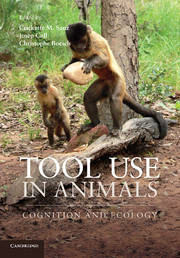Book contents
- Frontmatter
- Contents
- List of contributors
- Part I Cognition of tool use
- Part II Comparative cognition
- 4 Insight, imagination and invention: Tool understanding in a non-tool-using corvid
- 5 Why is tool use rare in animals?
- 6 Understanding differences in the way human and non-human primates represent tools: The role of teleological-intentional information
- 7 Why do woodpecker finches use tools?
- Part III Ecology and culture
- Part IV Archaeological perspectives
- Index
- References
4 - Insight, imagination and invention: Tool understanding in a non-tool-using corvid
from Part II - Comparative cognition
Published online by Cambridge University Press: 05 March 2013
- Frontmatter
- Contents
- List of contributors
- Part I Cognition of tool use
- Part II Comparative cognition
- 4 Insight, imagination and invention: Tool understanding in a non-tool-using corvid
- 5 Why is tool use rare in animals?
- 6 Understanding differences in the way human and non-human primates represent tools: The role of teleological-intentional information
- 7 Why do woodpecker finches use tools?
- Part III Ecology and culture
- Part IV Archaeological perspectives
- Index
- References
Summary
Introduction
The ability of animals to use tools has tended to represent a hallmark of intelligent behavior; i.e., those species that use tools are thought to be smarter than those species that do not. However, many species have been described as tool users, including species that we do not traditionally endow with complex cognition (Beck, 1980). For example, sea otters float with flat rocks on their chests onto which they break shellfish; green herons lower bait or lures (feathers, flowers or insects) onto the surface of the water to attract fish, which they then catch. Tool manufacture, rather than tool use per se, may be a finer-grade distinction in terms of intellectual capacity.
Evidence supporting a relationship between tool use and intelligence can be seen in analyses of species of birds and mammals who demonstrate true tool use (i.e., use of objects detached from the environment as tools, such as probes or hammers), have relatively larger brains than species which either do not use tools, or which only demonstrate proto-tool use (i.e., use of objects in situ to facilitate the function of an action, such as dropping shells onto a rock to break them; Lefebvre et al., 2002; Reader & Laland, 2002). It not clear whether these are meaningful relationships due to issues with the data used (see below) or the result of some other factor, such as the diet of tool users being better than non-tool users, which has the resultant effect of causing increases in brain size.
- Type
- Chapter
- Information
- Tool Use in AnimalsCognition and Ecology, pp. 67 - 88Publisher: Cambridge University PressPrint publication year: 2013
References
- 11
- Cited by



